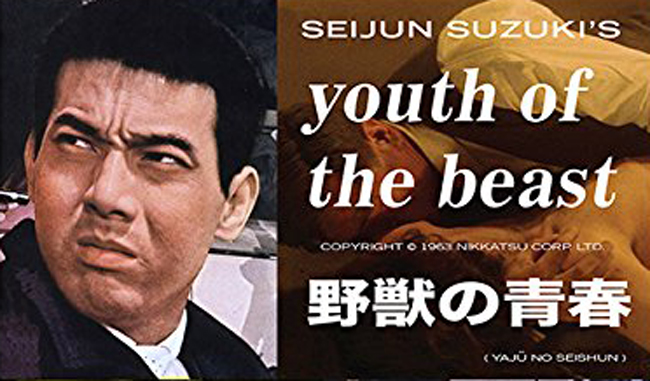
Youth Of The Beast Review
 Japanese cinema is very genre based with each genre having a sub-genre. One such popular one that emerged in the 1960s was the so-called Yakuza film usually involving a hit-man facing some kind of life challenge. This particular genre lasted roughly between 1963 through to the mid-1970s. One of the chief exponents of this series was a rather radical director called Seijun Suzuki. Suzuki was a director who was not so popular in his day but has subsequently become something of a cult director. He controversially directed a film in 1967 which to all intense and purposes ended his career while ultimately making him a cult icon. This film was called Branded to Kill (recently re-released by Arrow) and for the Nikkatsu studio the violent, sexy, incoherent and stylish film was too much for the studio who unceremoniously sacked him and made him into a pariah. Following this Suzuki spent years in the wilderness as a filmmaker. However, the reaction led to a big protest by artists and radicals who leafleted the studios. Indeed that arty style visible in Branded to Kill can also be seen in his earlier film, Youth of the Beast (1963), now released on the Eureka! Masters of Cinema label. Suzuki was a prolific director who made some 40 films between 1956 and his last film in 1967 (although after 1977 and more recently in the 2000s he has made a couple of other notable films). But it was Youth of the Beast made in 1963 which became the director’s signature film.
Japanese cinema is very genre based with each genre having a sub-genre. One such popular one that emerged in the 1960s was the so-called Yakuza film usually involving a hit-man facing some kind of life challenge. This particular genre lasted roughly between 1963 through to the mid-1970s. One of the chief exponents of this series was a rather radical director called Seijun Suzuki. Suzuki was a director who was not so popular in his day but has subsequently become something of a cult director. He controversially directed a film in 1967 which to all intense and purposes ended his career while ultimately making him a cult icon. This film was called Branded to Kill (recently re-released by Arrow) and for the Nikkatsu studio the violent, sexy, incoherent and stylish film was too much for the studio who unceremoniously sacked him and made him into a pariah. Following this Suzuki spent years in the wilderness as a filmmaker. However, the reaction led to a big protest by artists and radicals who leafleted the studios. Indeed that arty style visible in Branded to Kill can also be seen in his earlier film, Youth of the Beast (1963), now released on the Eureka! Masters of Cinema label. Suzuki was a prolific director who made some 40 films between 1956 and his last film in 1967 (although after 1977 and more recently in the 2000s he has made a couple of other notable films). But it was Youth of the Beast made in 1963 which became the director’s signature film.
Much of the later style of Suzuki is much in evidence in Youth of the Beast which starred Suzuki regular, hamster cheeked Jo Shishido who always had a mixture of edginess and casual laid back attitude about him. In Youth of the Beast Shishido plays an ex-cop whose violence impresses a local hood. The film opens with the murder of a cop who has been found dead with a call girl. There is suspicion surrounding this new enigmatic figure with those within the gangster organization wishing to challenge him. It soon becomes apparent that there is a connection between the dead cop and Jo as well as the connection of the call girl having worked for the crime boss.
As is often the case, the plot of Youth of the Beast is not exceptional but the stylishness by Suzuki is. The stylised violence is very similar in the way it is presented to that visible in a Quentin Tarantino film demonstrated by the disparate side characters in the film such as the partner only interested in guns and rejects women or the camp and gay gangster who cuts up the face of anyone who mentions his ex-prostitute mother, the drug addicted escort dying for her next fix or the curious detail of a knitting school being included in the plot. There are also some very stylish and original flashes such as the violent beating and shooting taking place in the gangster’s meeting room while we see a feathered stripper dancing in the club silently behind a two way mirror or the scene when Jo is tortured with a close up of a knife going under Jo’s fingernails. These are what can be called very Tarantino-like flourishes. It’s true that Shishido is not a great constructor of films, his editing definitely seems erratic but the misè-en-scene he displays are beautifully framed images. There are many frames within frames throughout the film – almost like a Japanese screen. These constructed images are visible in the film from the opening shots of a street scene which are shot in black and white until we see the credits in green and the sole focus in colour of a flower before the film kicks into full colour. Here is where the Blu-ray comes into its own with its sharp pictures in typically fine transfer of the film by Eureka! with enough grain to give some aged authenticity. The extras on the disc is a fascinating 40 page booklet and a 25 minute introduction to the film and career of Seijun Suzuki by Japanese film historian and expert Tony Rayns. Recommended to any fans of cult classics in search of something new or even dare I say it fans of pre-Tarantino type films.
Chris Hick
